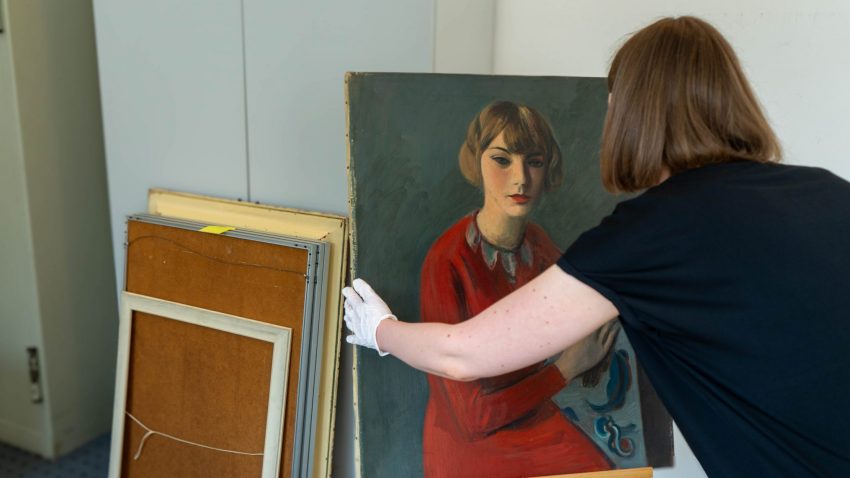Art treasure unearthed Cataloguing and visualising the "Straßner Collection"
The University Library of Technische Universität Braunschweig holds an art collection that is currently being catalogued and made visible. In this interview, Dr. Laura Breede, an art historian and researcher at the university archive, gives an insight into the project, which is funded by the Braunschweig Foundation for Cultural Heritage.

Laura Breede examines the painting “Lilo” by Rudolf Levy. Photo credit: Henning Peters/ TU Braunschweig
What does an art collection do at TU Braunschweig?
The art collection that we now call the “Straßner Collection” was assembled between the 1950s and 1970s for the former College of Education. It was initiated by the artist and professor of art education Ernst Straßner – hence the name “Straßner Collection”. At the time, the collection served as a kind of teaching collection as part of the art education course – a former member of Straßner’s staff described it as a “place of learning”. It also decorated the public rooms of the teacher training college. It was therefore not only accessible in a designated place or to a small circle, but was visible to all members of the university – for example, in the anteroom of the lecture hall of what is now the House of Science. Among the works on display were two Italian landscapes and a floral still life by Hans Purrmann in bright oils on canvas from the 1950s, woodcuts by Gerhard Marcks, and lithographs and etchings with mythological and religious motifs by Lovis Corinth. The oldest work in the collection, a small, delicate lithograph of a female nude from behind by the French artist Aristide Maillol from 1895, was also presented in an adjoining room.
Is the collection still open to the public?
With a few exceptions, the works are not currently on display. I am working on changing this as part of a project to make the collection accessible and visible. The works are stored in the stacks of the University Library. They were moved there in the 1980s after valuable prints and drawings were stolen from rooms open to the public. When a three-hundred-pound bronze sculpture was stolen during building work, the collection was transferred to the University Library, but has been almost forgotten in recent years.
For about a year I have been working on analysing the genesis and history of the collection and researching the individual pieces. The next step will be to make these findings visible, initially in the form of a collection catalogue and an online presentation. I am particularly pleased to have succeeded in presenting the entire collection as part of an exhibition, the concept for which I am currently developing, at the Braunschweig Stadtmuseum from the beginning of 2025. The exhibition will also focus on the history of the collection and take a critical look at Straßner, who initiated the collection, and his biography. Above all, however, it will focus on the collected works and examine them in the context of post-war art discourse.
What is your favourite work in the collection?
I particularly like a painting by the artist Rudolf Levy. It’s a somewhat enigmatic portrait of a young woman called Lilo, probably painted in 1930 – that’s the title. We don’t know who she is or what her relationship was with the artist. But she makes very direct contact with us, the viewer, by looking out of the picture at us. She is not smiling, her gaze is confident, but also a little melancholy. The bright red colour of her dress, which is reflected in her lips, and the very pale incarnation are particularly striking. Levy’s life story is moving and dramatic: at the beginning of the 20th century, he was part of the illustrious Parisian artistic circles around Henri Matisse, but he also lived in other European countries and in the USA. After the Nazis came to power, he was ostracised as a German-Jewish artist, his work defamed as degenerate and his paintings confiscated from collections. In 1944 he was deported from Milan to Auschwitz, where he probably did not survive. We already know that the painting came from a close friend and collector of Levy’s and was legally acquired by a gallery in the post-war period.
Is the collection made up entirely of paintings and how large is it?
The works are mainly prints in various techniques, such as lithographs, etchings, woodcuts, silkscreen prints and oil, tempera and watercolour paintings. The bronze relief in the staircase of the building at Bültenweg 74/75 is also part of the collection. The works cover a period of about 90 years: the oldest lithograph mentioned above is by Aristide Maillol from 1895, while the most recent silkscreens are by Siegfried Neuenhausen, Gerd Winner and Friedensreich Hundertwasser, among others, from the 1970s.
The collection originally comprised almost 130 works – today we still have just over 100. As already mentioned, some have unfortunately been stolen, but others may still be in TU buildings of which we are unaware. Fortunately, in recent months we have been able to locate some works that were hanging in offices and bring them together with the collection. Our aim is to keep the collection as complete as possible in one place and under safe conservation conditions.
Does this mean that some works of art are still being sought?
That’s right. It would be wonderful if more artworks could be found to complete the collection. We would be delighted if members of staff at the University Archives could get in touch and let us know in which rooms – perhaps even in their own offices – there are pictures, such as prints, drawings or paintings, hanging on the wall, the origin or provenance of which is uncertain. We will then check whether the pictures belong to the collection, and if they do, you will have helped us a great deal to better understand and protect the works in the collection!
Thank you very much for this interview!
